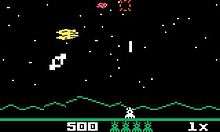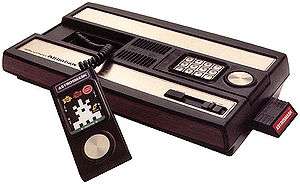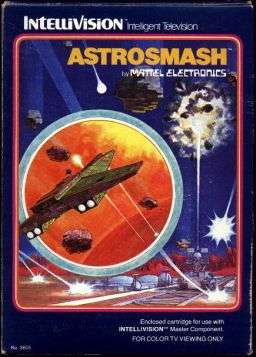Astrosmash
| Astrosmash | |
|---|---|
|
Intellivision cover art | |
| Developer(s) | Mattel |
| Publisher(s) | Mattel |
| Designer(s) | John Sohl, Hal Finney |
| Platform(s) | Intellivision, Atari 2600 Mattel Aquarius |
| Release date(s) |
‹See Tfd› ‹See Tfd›
|
| Genre(s) | Fixed shooter |
| Mode(s) | Single-player |
Astrosmash is a video game for the Intellivision videogame console, designed by John Sohl, and released by Mattel Electronics in 1981. The game involves using a laser cannon to destroy falling meteors, bombs, and other targets.[2] More than one million copies were sold, and the game replaced Las Vegas Poker & Blackjack as the game included with the Intellivision console.[3]
Basic description
The Intellivision game catalog features the exciting caption, "Spin. Blast. And drop into hyperspace to avoid a killer asteroid shower. Power on. Attack computer engaged. Fire a quick burst at the alien antagonists. Got 'em!"[4][5] The actual package gives a more specific description: "You're in command of a battery of laser guns. You have unlimited ammo and a lot of targets! You can roll up big scores by hitting a spectactular barrage of falling rocks, bombs, guided missiles and attacking UFOs..."[2]
Astrosmash resembles a cross between the early arcade games Space Invaders and Asteroids. The player controls a laser cannon that can scroll left or right along a flat plane in order to target falling objects, such as large or small meteors, large or small spinning bombs, and guided missiles, as well as a UFO that crosses the screen from time to time at higher levels.[6] Low hills and stars are seen in the background. Unlike in Space Invaders, the player does not face direct enemy fire, cannot hide beneath bunkers, and the game does not end when targets hit the ground.[2]
Gameplay

There are four types of targets, each of which may move at at a range of speeds. As the game advances, the range of speeds for each type of target increases.[7]
- The bulk of the targets are meteors, which come in two sizes and various colors. Both sizes fall vertically when entering the screen. Large meteors may be destroyed with a direct hit, or may split into two smaller meteors, which fall diagonally in opposite directions. Small meteors are destroyed with a single hit.
- The player must also shoot spinning bombs, or spinners, which are white, come in two sizes, and spin while falling vertically. Each spinner emits a loud whistling sound, which gradually lowers in pitch as it approaches the ground.
- Guided missiles appear occasionally as white dots making a pulsing sound, and may fall diagonally toward the player's initial location, or track the laser cannon as it moves left and right. If a missile reaches the ground, it may disappear, or it may continue to track left or right, and can only be avoided by entering hyperspace. The missile may change directions several times before disappearing.
- UFOs may cross the screen occasionally, beginning at level 4, firing non-guided salvos aimed at the player's laser cannon.
The player loses a laser cannon each time it is hit by a falling meteor, a guided missile, a non-guided salvo, or by shrapnel from a nearby explosion, and any time a spinner reaches the ground, even if it does not strike the gun. Each target hit increases the player's score; it decreases by half as much each time a meteor reaches the ground, or a laser cannon is destroyed. An extra gun is awarded each time the player's peak score increases by 1,000 points.[7]
The game has six levels, each of which features increased speed and scoring. Each level is represented by a differently-colored background. Level 1, up to 999 points, is black; level 2, from 1,000 to 4,999 points, is blue; level 3, from 5,000 to 19,999 points, is purple; level 4, from 20,000 to 49,999 points, is turquoise; level 5, from 50,000 to 99,999 points, is gray; and level 6, above 100,000 points, is black again. Speed continues to increase along with the player's peak score, at 200,000, 500,000, and 1,000,000 points.[7]
The player has the option of firing single shots by pressing the fire buttons, or switching to automatic fire at a rate of three shots per second. The hyperspace option moves the gun to a random location, which may or may not be safer than the starting point. The game can also be paused at any time.[7]
Development

Astrosmash was originally conceived when a game called Meteor!, an Asteroids clone, did not fill up the ROM space of an entire cartridge. The extra space was used to create a variation of the game called Avalanche! The Meteor! game was cancelled at the last minute, due to concerns that it was too similar to Asteroids.[3][6] Programmer John Sohl programmed a "branch" around the opening-screen menu, leading directly to the Avalanche! variation, retitled Astrosmash. The games were compatible, since they were designed together, and used the same sprites and sound effects. In rare instances, if the console's reset button is pressed rapidly, an error can occur, resulting in the game starting in the original Meteor! format.[5]
A cut-down version of Astrosmash was released for the Atari 2600 console under Mattel's "M Network" label as Astroblast. Telegames later re-published the game under the Telegames brand.
A version of Astrosmash was made available on Microsoft's Game Room service for its Xbox 360 console and for Windows-based PCs, beginning on March 24, 2010.
Another version of the game, loosely based on the original, was announced for the PlayStation 3 through PlayStation Home in fall 2012, as part of a collection titled Intellivision Gen2. In comparison to the original, the game was expected to feature more types of UFOs, more pronounced difficulty level progressions, and base weapon power-ups.
Reception
Astrosmash was reviewed in 1982 by Video magazine where it was described as "an obvious attempt to provide Intellivision-ites with a solitaire arcade-style target game". The pacing of the early stages in the game was described as "dull and plodding", although later in the game the pace becomes much more challenging. The color-coding of stages corresponding with difficulty level and player score was described as "not a bad idea", but reviewers noted that "the greyish blue used for the 1000-to-4999-point range is especially odious" and described this hue as "assaulting the optic nerves". Despite the lackluster review, the game was ultimately recommended as "probably worth a try" for Intellivision users seeking a new experience because the Intellivision "traditionally lacks arcade programs",[8]:42 and eight months later in Video's 1982 Guide to Electronic Games, Astrosmash was described as "probably the most popular action game produced by Mattel for play on the Intellivision".[9]:53
Notes
- The large "spinner" sprite was also used to represent hurricanes in the Intellivision game Utopia.[10]
- In several first-season episodes of The Flash, the character of Cisco Ramon wears an Astrosmash T-shirt.[11]
References
- ↑ GameFAQs
- 1 2 3 Astrosmash, Mattel Electronics (1981).
- 1 2 "Mattel Intellivision - 1980-1984". ClassicGaming. IGN. Archived from the original on 23 June 2008. Retrieved 2008-05-16.
- ↑ Intellivision game catalog, Mattel Inc. (1982).
- 1 2 intellivisionlives.com
- 1 2 Brett Weiss, Classic Home Video Games, 1972–1984: A Complete Reference Guide, McFarland (2007).
- 1 2 3 4 Astrosmash Cartridge Instructions, Mattel Inc. (1981).
- ↑ Kunkel, Bill; Katz, Arnie (March 1982). "Arcade Alley: Mixed Reviews for Intellivision". Video. Reese Communications. 5 (12): 40–42. ISSN 0147-8907.
- ↑ Kunkel, Bill; Katz, Arnie (November 1982). "Video's Guide to Electronic Games". Video. Reese Communications. 6 (8): 47–56, 108. ISSN 0147-8907.
- ↑ Utopia, Mattel Electronics (1981).
- ↑ The Flash, Warner Bros. Television (2014).
External links
- Blue Sky Rangers - Space Action Network page
- The Dot Eaters article on Astrosmash, Sohl and the Intellivision
